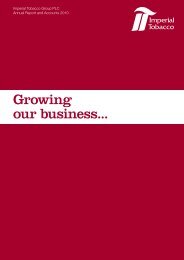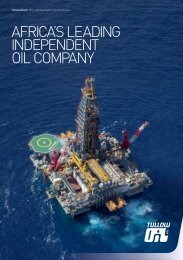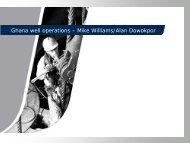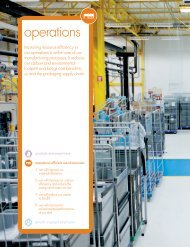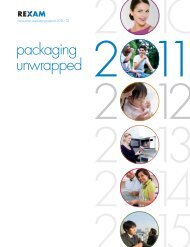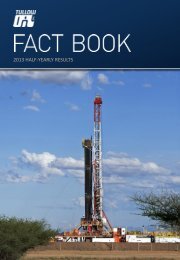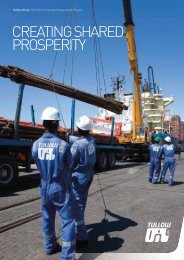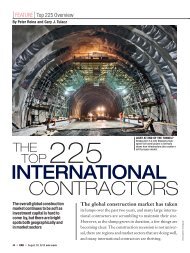Tullow safety rules - The Group
Tullow safety rules - The Group
Tullow safety rules - The Group
Create successful ePaper yourself
Turn your PDF publications into a flip-book with our unique Google optimized e-Paper software.
<strong>Tullow</strong> Oil plc<br />
SAFETY RULES
<strong>Tullow</strong> Safety Rules<br />
TABLE OF CONTENTS<br />
SECTION 1. OVERVIEW<br />
SECTION 2. VISION<br />
SECTION 3. SCOPE AND APPLICATION<br />
SECTION 4. ROLES AND RESPONSIBILITIES<br />
4.1 Regional Business Manager<br />
4.2 Country Manager<br />
4.3 <strong>Group</strong> EHS Manager<br />
4.4 All Personnel<br />
SECTION 5. COMMITMENT AND EXPECTATION<br />
5.1 <strong>Tullow</strong>’s Commitment<br />
5.2 <strong>Tullow</strong>’s Expectations<br />
SECTION 6. FOUNDATION FOR OPERATIONS<br />
SECTION 7. VARIANCE<br />
SECTION 8. AUDITING AND COMPLIANCE<br />
8.1 Intent<br />
8.2 Self-Assessment<br />
8.3 Findings and Action Management<br />
SECTION 9. DOCUMENT CONTROL AND REVIEW<br />
SECTION 10. DEFINITIONS<br />
SECTION 11. TULLOW SAFETY RULES<br />
Rule 1: Permit to Work<br />
Rule 2: Energy Isolation<br />
Rule 3: Working at Height<br />
Rule 4: Lifting Operations<br />
Rule 5: Excavation Work<br />
Rule 6: Confined Space Entry<br />
Rule 7: Process Safety<br />
Rule 8: Management of Change<br />
Rule 9: Driving Safety<br />
Rule 10: Hazardous Materials<br />
Rule 11: Contractor Management<br />
Rule 12: Environmental Management<br />
Rule 13: Health and Hygiene<br />
Page 2<br />
Page 3<br />
Page 4<br />
Page 5<br />
Page 5<br />
Page 5<br />
Page 5<br />
Page 5<br />
Page 6<br />
Page 6<br />
Page 6<br />
Page 7<br />
Page 7<br />
Page 8<br />
Page 8<br />
Page 8<br />
Page 8<br />
Page 9<br />
Page 10 & 11<br />
Page 12<br />
Page 13<br />
Page 14<br />
Page 15<br />
Page 16<br />
Page 17<br />
Page 18<br />
Page 19<br />
Page 20<br />
Page 21<br />
Page 22<br />
Page 23<br />
Page 24<br />
Page 25<br />
Page 1
<strong>Tullow</strong> Safety Rules<br />
SECTION 1<br />
OVERVIEW<br />
<strong>The</strong> <strong>Tullow</strong> Safety Rules are a set of requirements designed to manage high risk activities that have the potential to<br />
adversely effect our personnel, the environment and surrounding communities.<br />
<strong>The</strong>se <strong>rules</strong> are established using industry practices, guidelines and standards and are intended to reinforce, but do not<br />
replace, <strong>Tullow</strong>’s standards or applicable host country regulatory commitments.<br />
Effective implementation of these <strong>rules</strong> will steer our company to our commitment of eliminating harm to our personnel,<br />
the environment and surrounding communities during the execution of our operations.<br />
<strong>Tullow</strong> is committed to supporting the effective implementation of these <strong>rules</strong>. Likewise, <strong>Tullow</strong> expects that everyone give<br />
their own commitment to adhering to these requirements in their work.<br />
Page 2
SECTION 2<br />
VISIONS<br />
<strong>Tullow</strong> is fully committed to supporting these <strong>rules</strong>.<br />
In order for the <strong>rules</strong> to be effective we all must adhere to the following fundamentals:<br />
• We must take accountability for our own <strong>safety</strong> and for the <strong>safety</strong> of others.<br />
• We must plan and subsequently execute our work to minimize the risks associated to our personnel, the environment<br />
and our surrounding community.<br />
• We must continually learn from others and our experiences so that we may evolve into a learning organisation.<br />
• We must engage with our contractors to enable them to implement the intent of these <strong>rules</strong> when engaged in activities<br />
not controlled by <strong>Tullow</strong>’s management systems.<br />
• We must all stop the job whenever we feel the protection of our personnel, the environment and surrounding<br />
communities are compromised.<br />
Page 3
<strong>Tullow</strong> Safety Rules<br />
SECTION 3<br />
SCOPE AND APPLICABILITY<br />
<strong>Tullow</strong> Safety Rules apply to all parts of <strong>Tullow</strong>’s operations and to all employees and contractors, involved in those<br />
activities. <strong>Tullow</strong>’s Businesses are required to manage EHS risks by developing and implementing procedures that define<br />
the relevant standards and processes intended to support the implementation of these <strong>rules</strong>.<br />
Contractors working under the <strong>Tullow</strong> management system must comply with these <strong>Tullow</strong> Safety Rules.<br />
Contractors working under their own management system should be encouraged to implement the intent of these <strong>rules</strong>.<br />
Where conflict exists between these <strong>rules</strong> and the applicable host country regulatory requirements, the more stringent<br />
will apply.<br />
Page 4
SECTION 4<br />
ROLES AND RESPONSIBILITIESS<br />
Everyone has an individual responsibility for their own <strong>safety</strong> and the <strong>safety</strong> of the people around them. <strong>The</strong> roles and<br />
responsibilities listed below cascade throughout the organisation.<br />
4.1 Regional Business Manager<br />
• Responsible for supporting the Country Manager’s implementation of the <strong>Tullow</strong> Safety Rules.<br />
• Responsible for assessing, evaluating and approving any variance from these <strong>rules</strong>.<br />
4.2 Country Manager<br />
• Accountable for the execution of <strong>Tullow</strong>’s operations in accordance with these <strong>rules</strong>.<br />
• Accountable for ensuring that all individuals fully understand these <strong>rules</strong> as they apply to their specific roles.<br />
• Accountable for demonstrating compliance with these <strong>rules</strong>.<br />
• Accountable for identifying, reporting and addressing any circumstances of non-compliance.<br />
• Responsible for ensuring that the self-assessment is carried out every two years.<br />
• Approval of self-assessment and associated action plan.<br />
4.3 <strong>Group</strong> EHS Manager<br />
• Accountable for developing and maintaining the <strong>Tullow</strong> Safety Rules.<br />
• Accountable for communicating these <strong>rules</strong> to the Business Units.<br />
• Accountable for revising these <strong>rules</strong> based on the performance, industry practice and regulatory requirements.<br />
• Accountable for supporting the Business Units in understanding and implementing these <strong>rules</strong>.<br />
• Responsible for collating, reviewing, trending and reporting the degree of compliance across <strong>Tullow</strong>’s operations.<br />
• Responsible for reviewing and endorsing any variances submitted by the Business.<br />
4.4 All Personnel<br />
• Responsible for understanding these <strong>rules</strong>.<br />
• Responsible for executing specific roles and responsibilities in accordance with these <strong>rules</strong>.<br />
• Responsible for reporting any circumstances of non-compliance.<br />
• Responsible for stopping the job in circumstances where the <strong>safety</strong> of people, the environment and surrounding<br />
communities are compromised.<br />
Page 5
<strong>Tullow</strong> Safety Rules<br />
SECTION 5<br />
COMMITMENT AND EXPECTATION<br />
5.1 <strong>Tullow</strong>’s Commitment<br />
<strong>Tullow</strong> is committed to the <strong>safety</strong> and wellbeing of its people, the environment and surrounding communities:<br />
In delivering this commitment <strong>Tullow</strong> will:<br />
• Identify risks associated with the execution of <strong>Tullow</strong>’s business.<br />
• Develop a set of mandatory <strong>rules</strong> that must be applied.<br />
• Communicate <strong>Tullow</strong>’s expectations and requirements to everyone engaged in the execution of <strong>Tullow</strong>’s business.<br />
• Allocate sufficient competent resources to support the effective implementation of these <strong>rules</strong>.<br />
• Require everyone to comply with these <strong>rules</strong>.<br />
• Require everyone to report any variances and/or violations.<br />
• Undertake assurance activities.<br />
5.2 <strong>Tullow</strong>’s Expectations<br />
<strong>Tullow</strong> expects each employee and contractor is able to return home at<br />
the end of the working day without having suffered or caused harm in any<br />
way to themselves, others, the environment or surrounding communities.<br />
In delivering this individual commitment <strong>Tullow</strong> expects:<br />
• <strong>The</strong> <strong>Tullow</strong> Safety Rules form part of induction processes.<br />
• All employees and contractors are conversant with the <strong>Tullow</strong><br />
Safety Rules.<br />
• Employees and contractors will only undertake work for which they<br />
have been trained and deemed competent.<br />
• All employees and contractors are personally accountable for the<br />
implementation of these <strong>Tullow</strong> Safety Rules as they apply to their<br />
specific role.<br />
• Any variance and/or violation is immediately reported.<br />
• All employees and contractors to intervene and stop work for<br />
instances where these <strong>Tullow</strong> Safety Rules are not adequately<br />
managing the risks.<br />
Page 6
SECTION 6<br />
FOUNDATION FOR OPERATIONS<br />
Fundamental requirements which are the foundation for EHS aspects of operations include:<br />
• Work will not be conducted without a task risk assessment and a <strong>safety</strong> discussion appropriate to that level of risk.<br />
• People will be trained, competent and fit to conduct the activity.<br />
• Personal Protection Equipment (PPE) will be worn as detailed in the risk assessment and minimum site requirements.<br />
• All equipment to be utilised must be fit-for-purpose. Equipment found to be damaged or defective is removed<br />
from service.<br />
• Rescue, recovery and emergency response plans and specified equipment, developed from a review of potential<br />
emergency scenarios, is in place before commencement of the activity.<br />
• Everyone has an obligation to stop work that is unsafe.<br />
SECTION 7<br />
VARIANCE<br />
A decision by a <strong>Tullow</strong> operation to deviate from any part of these <strong>rules</strong> must be based on a formal documented risk<br />
assessment and justification. <strong>The</strong> justification must be reviewed and approved by the respective <strong>Tullow</strong> Regional Business<br />
Manager and endorsed by the <strong>Group</strong> EHS Manager prior to the execution of the activity.<br />
Any authorisation of a deviation under this process must be reviewed as part of the self-assessment every two years.<br />
Page 7
<strong>Tullow</strong> Safety Rules<br />
SECTION 8<br />
AUDITING AND COMPLIANCE<br />
<strong>The</strong> Regional Business Units are responsible for demonstrating and reporting compliance with these <strong>rules</strong>.<br />
Demonstration and compliance reporting must be performed in accordance with the self-assessment process every<br />
two years.<br />
8.1 Intent<br />
Each Business Unit must perform a self-assessment against these <strong>rules</strong>, with the intent of:<br />
• Providing assurance that controls are in place and effective in managing risks associated with these activities.<br />
• Demonstrating overall compliance with these <strong>rules</strong> by assessing whether systems are adequately documented,<br />
understood by personnel and effectively implemented.<br />
• Providing a compliance reporting structure whereby any lessons learned can be identified, communicated and<br />
implemented.<br />
8.2 Self-Assessment<br />
Compliance to these <strong>rules</strong> must be demonstrated every two years by using the <strong>Tullow</strong> Safety Rules Self-Assessment Toolkit.<br />
EHS Functional <strong>Group</strong> is responsible for the development, maintenance and issue of the toolkit at least three months prior<br />
to the submission deadline, which will be agreed with the <strong>Group</strong> EHS Manager.<br />
<strong>The</strong>se <strong>rules</strong> are mandatory and as such must be fully implemented to manage all <strong>Tullow</strong>’s operations. <strong>The</strong> level of<br />
compliance is based on a simple comply / not comply principle as the mandatory nature of these <strong>rules</strong> will not support<br />
partial implementation.<br />
<strong>The</strong> self-assessment team must collate evidence in order to demonstrate compliance / non-compliance with the<br />
relevant rule. <strong>The</strong> following items may be used as a form of evidence.<br />
• Documentation – demonstration that written standards, processes or procedures exist and are adequate in supporting<br />
the implementation of these <strong>rules</strong>.<br />
• Interviews – demonstration that specific individuals have an understanding of their roles and responsibilities.<br />
• Observations – demonstration that activities are performed in accordance with defined standards, processes<br />
and procedures. Observations provide evidence, regardless of an individual’s knowledge of <strong>rules</strong>, of whether activities<br />
are collectively performed as per the defined requirements.<br />
• Any approved and endorsed variances.<br />
8.3 Findings and Action Management<br />
All actions must be assigned a responsible party, appropriate completion date, managed in an action management system<br />
and be retained for reference in future audits.<br />
<strong>The</strong> relevant Country Manager will approve the self-assessment and associated action plan.<br />
Page 8
SECTION 9<br />
DOCUMENT CONTROL AND REVIEW<br />
<strong>The</strong> <strong>Group</strong> EHS Manager is responsible for the development, maintenance and revision of these <strong>rules</strong>.<br />
<strong>The</strong>se <strong>rules</strong> must be subject to review. <strong>The</strong> reviews should be based on:<br />
• Corporate objectives and targets.<br />
• EHS performance e.g. incidents, self-assessment findings etc.<br />
• Regulatory requirements.<br />
• Industry practice.<br />
Page 9
<strong>Tullow</strong> Safety Rules<br />
SECTION 10<br />
DEFINITIONS<br />
Permit to Work<br />
A controlled document identifying hazards and setting measures to manage risks associated with the actual task and any<br />
potential interfacing tasks. A permit to work is required for, but not limited to, confined space entry, excavation work,<br />
work on energised systems (electrical, mechanical, hydraulic, thermal), hot work, heavy lifts, working at heights,<br />
work with hazardous materials (including radioactive sources) and any non-routine activities. Local procedures may<br />
require a PTW for additional activities.<br />
Excavation Work<br />
Work to form a cut, cavity, trench or depression in the earth’s surface by earth removal or by other ground disturbance.<br />
Confined Space<br />
An enclosed or partially enclosed space:<br />
• Not intended or designated primarily as a place of work.<br />
• With restricted means for entry and exit.<br />
• At atmospheric pressure when occupied.<br />
Which may at any time:<br />
• Have a potentially harmful atmosphere.<br />
• Have an oxygen deficiency or excess.<br />
• Cause engulfment.<br />
Hazardous Material<br />
A solid, liquid, or vapour (gas) that when released into the environment could cause illness, injury, or death to people<br />
or destruction of the environment if improperly treated, stored, handled, transported, or discarded. Substances are<br />
considered hazardous if they are:<br />
• Ignitable.<br />
• Corrosive.<br />
• Reactive.<br />
• Toxic.<br />
Mixtures, residues, or materials containing hazardous wastes are also considered hazardous materials.<br />
Contractor<br />
Any person(s) or company contracted by <strong>Tullow</strong> to provide services in support of the execution of <strong>Tullow</strong>’s business.<br />
Competent Person<br />
A competent person is someone who has sufficient training, experience and/or knowledge to undertake the task being<br />
asked of them.<br />
Page 10
Working at Height<br />
All personnel, when engaged in work 2 metres (or 6 feet) or more above a working surface or where a fall could result in a<br />
significant injury e.g. water; should be protected at all times from falling by guardrail systems, fixed platforms or personal<br />
fall arrest systems. Note: Risk of significant injuries may occur from heights less than 2 metres (or 6 feet), as such,<br />
appropriate controls and mitigation measures must be in place to manage such risks.<br />
Management of Change<br />
A process for the identification, evaluation and approval of change that ensures risks associated with specific changes are<br />
managed prior to the execution of the change and commencement and/or continuation of activities.<br />
Lifting Operations<br />
Lifting operations are defined as activities associated with the lifting and lowering of a load i.e. includes movement,<br />
which may include both horizontal and vertical, of the supported load.<br />
Risk Assessment<br />
A process by which hazards are identified and evaluated for a specific activity, and control and mitigation measures<br />
implemented to prevent and mitigate potential hazards that have the potential to adversely impact the protection of people,<br />
the environment and surrounding communities.<br />
Non-routine activity<br />
An activity that is being performed sufficiently infrequently that could potentially lead to the inadequate identification of<br />
hazards and ineffective implementation of controls.<br />
Safety Critical Equipment<br />
Safety Critical Equipment can prevent, control or mitigate major accident events and the failure of which could cause or<br />
contribute substantially to a major accident event.<br />
HAZOP<br />
A Hazard and Operability (HAZOP) study is a structured and systematic examination of a process or operation in order to<br />
identify and evaluate hazards that may represent risks to personnel or equipment, or prevent efficient operation.<br />
Major Accident Event<br />
An accident involving loss of life on a site / facility of five or more people resulting in damage to equipment leading to<br />
stoppage of process or adverse effects to the environment.<br />
Zero Energy State<br />
<strong>The</strong> dissipated energy state whereby no stored energy can be released and all electrical sources are grounded.<br />
Page 11
<strong>Tullow</strong> Safety Rules<br />
SECTION 11<br />
TULLOW SAFETY RULES<br />
<strong>The</strong> <strong>Tullow</strong> Safety Rules cover the following activities:<br />
Rule 1:<br />
Rule 2:<br />
Rule 3:<br />
Rule 4:<br />
Rule 5:<br />
Rule 6:<br />
Rule 7:<br />
Rule 8:<br />
Rule 9:<br />
Rule 10:<br />
Rule 11:<br />
Rule 12:<br />
Rule 13:<br />
Permit to Work<br />
Energy Isolation<br />
Working at Heights<br />
Lifting Operations<br />
Excavation Work<br />
Confined Space Entry<br />
Process Safety<br />
Management of Change<br />
Driving Safety<br />
Hazardous Materials<br />
Contractor Management<br />
Environmental Management<br />
Health and Hygiene<br />
Page 12
Rule 1<br />
Permit to work<br />
Intent<br />
To provide a standard for the management of high risk activities and ensure that permit to work procedures are<br />
implemented by the business and that they are adequate, communicated and formally controlled.<br />
Requirements<br />
• A formal written work permit must be obtained prior to the<br />
commencement of work involving confined space entry, work<br />
on energised systems (electrical, mechanical, hydraulic, thermal),<br />
hot work, heavy lifts, working at heights, work with hazardous<br />
materials (including radioactive sources) and non-routine activities.<br />
• A task risk assessment must be conducted with all personnel<br />
involved in or impacted by the permitted work.<br />
• <strong>The</strong> work permit documentation must ensure:<br />
- <strong>The</strong>re is a clearly defined scope, location of work and validity<br />
period.<br />
- All hazards associated with the work have been identified and risk<br />
assessed.<br />
- All controls identified to manage the risks associated with the<br />
hazards are communicated to all involved in the work,<br />
implemented and verified.<br />
- A responsible person for the specific work location must authorise the work.<br />
--<strong>The</strong> responsible person must verify that the controls are adequate and in place prior to authorization and<br />
commencement of the work.<br />
--Any electrical and/or mechanical isolations are referenced on the permit, in place and verified as such.<br />
--No conflicting work activities exist that could potentially adversely effect the controls or introduce additional hazards.<br />
--Personnel conducting the work acknowledge the risks and agree to the controls identified to manage such risks.<br />
--Those accountable and responsible persons authorise, monitor and revalidate the work permit.<br />
--Relevant risk assessment and/or associated certificates are referenced on the work permit.<br />
• All work permits must be displayed at the work site and central site/facility control centre.<br />
• All work permits must be managed from a central location on the site or facility.<br />
• A competent person must be appointed to manage the permit to work system.<br />
• A system for the management, authorisation and communication of work permits that extend beyond the validity period<br />
must be in place.<br />
Page 13
<strong>Tullow</strong> Safety Rules<br />
Rule 2<br />
ENERGY ISOLATION<br />
Intent<br />
To provide a standard for the management of risks associated with work requiring energy (process, mechanical, electrical,<br />
instrument, hydraulic) isolations, such that energy sources are identified, isolated, tested and communicated to appropriate<br />
personnel before work shall proceed.<br />
Requirements<br />
• A written work permit must be obtained prior to the<br />
commencement of any work on a system requiring energy<br />
isolation.<br />
• Personnel involved in isolations will be trained and competent.<br />
• A task risk assessment must be conducted with all personnel<br />
involved in or impacted by the permitted work.<br />
• A system for the use of locks, tags or physical removal or<br />
separation of components to isolate energy sources must be<br />
developed and in place to ensure positive protection is provided.<br />
• Locks used in the isolation of energy sources must be adequately<br />
designed to prevent any inadvertent or malicious de-isolation<br />
of a source.<br />
• All isolated energy sources must be tested and verified to ensure<br />
that the source is effectively isolated.<br />
• Isolation effectiveness must be periodically tested and verified.<br />
• Isolations and/or de-isolations must be conducted, tested and<br />
verified by a competent person.<br />
• A test procedure must be in place for the verification of a<br />
positive isolation.<br />
• <strong>The</strong> duration of an isolation must be defined on the written<br />
work permit and a system must be developed and in place that<br />
manages the:<br />
- Hand-over of an isolation to another responsible person, and<br />
- Removal of isolation by an alternate responsible person not<br />
initially identified on the written work permit.<br />
• A system must be developed and in place that manages<br />
circumstances where any one of the following is not achievable:<br />
--A zero energy state,<br />
--A test/try of isolation, or<br />
--Use of a locking device.<br />
Page 14
Rule 3<br />
WORKING AT HEIGHT<br />
Intent<br />
To provide a standard for the management of risks associated with working at height and ensure that the procedures<br />
established by the Business considers the identification and control of working at height activities. Working at height<br />
is defined as work at 2 metres (or 6 feet) or more above a working surface or any height whereby there in potential for<br />
significant injury if you fall.<br />
Note: Risk of significant injuries may occur from heights less than 2 metres (or 6 feet), as such, appropriate controls and<br />
mitigation measures must be in place to manage such risks.<br />
Requirements<br />
• Working at height activities must only be conducted after alternatives, which avoid working at height have been<br />
considered, evaluated and discounted.<br />
• Where possible a fixed platform with guards, handrails and kick plates should be used. Such platforms or scaffold<br />
erections must be initially checked and signed off by a Competent Person prior to initial use.<br />
• A task risk assessment must be conducted for all working at height activities with all personnel involved in or impacted<br />
by the activity. Consideration should be given to the work environment (rotating machinery, lifting operations etc.)<br />
and the most appropriate form of controls.<br />
• Working at height activities must only be performed by trained and competent individuals.<br />
• Working at height activities must never be performed alone.<br />
• Ensure that the area below is cordoned off and that appropriate notifications are communicated and posted.<br />
• Ensure that all tools used at height are always secured from free fall and removed from height upon temporary<br />
suspension or completion of the activity.<br />
• All working at height activities must be performed using a personal fall arrest system, consisting of a full body harness,<br />
shock absorber and lanyard which limits the fall to 2 metres (or 6 feet) or less.<br />
• <strong>The</strong> personal fall arrest system and associated equipment must be visually inspected prior to use and immediately<br />
removed from service if any defects exist.<br />
• Individuals working at height must remain attached to a suitable anchor point at all times. Where movement at height<br />
is necessary a double lanyard will be used.<br />
• A suitable anchor point preferably overhead must be selected to reduce the overall potential fall distance.<br />
• All anchor points must be sufficiently designed to withstand the potential shock load of an individual falling from height.<br />
• A rescue plan and associated equipment must be in place prior to the commencement and/or continuation of an<br />
activity at height.<br />
• A preventative maintenance system must be in place to ensure that all fall arrest equipment is maintained and in a<br />
serviceable condition.<br />
Page 15
<strong>Tullow</strong> Safety Rules<br />
Rule 4<br />
LIFTING OPERATIONS<br />
Intent<br />
To provide a standard for the management of risks associated with lifting operations (which involve cranes, hoists, chain<br />
blocks or other mechanical lifting devices) and ensure that the procedures established by the Business considers the<br />
identification and control of lifting activities.<br />
Requirements<br />
• Cranes must be subject to daily visual inspections of wire ropes, sheaves, hoses and general condition and include<br />
tests to confirm the correct operation of all limit switches, shutdowns, load indicators, alarms and other<br />
<strong>safety</strong> devices.<br />
• <strong>The</strong> Safe Working Load (SWL) must be clearly identified and marked on all cranes and relevant lifting equipment and<br />
must not be exceeded by static or dynamic loads.<br />
• Suitably qualified, certified and competent person(s) must be involved in the planning, supervision and execution of<br />
lifting operations.<br />
• Man-riding operations using work baskets (or similar) will only be permitted following specific risk assessment.<br />
All equipment used for man-riding operations must be specifically designed, certified and identified as suitable<br />
for such operations.<br />
• Clear lines of communications between all person(s) involved in the lifting operations must be established and<br />
maintained.<br />
• A dedicated signalman must be appointed to all lifting operations and must ensure that the lines of communications<br />
are established with the crane operator.<br />
• Lifting operations must only be performed within the manufacturers recommended adverse weather limits.<br />
• Lifting operations must be performed in a manner that eliminates person(s) under the load or between a suspended<br />
load and fixed object.<br />
• Lifting operations when lifting near or over unprotected plant, equipment or services, including live process plant or<br />
hydrocarbon processes must be risk assessed to identify hazards, controls and mitigations measures designed to<br />
eliminate or minimise risks.<br />
• Lifting equipment must be fit-for-purpose, certified, managed and maintained in accordance with a site / facility lifting<br />
equipment register.<br />
• A preventative maintenance system must be in place to ensure that all cranes and lifting equipment are maintained<br />
and in a serviceable condition.<br />
• All lifting equipment is subject to a visual inspection by a competent person prior to every lift.<br />
• Safety devices are operable for every lifting operation.<br />
• Any modification to cranes and lifting equipment must be subject to the original equipment manufacturer’s approval<br />
and managed in accordance with the management of change process.<br />
Page 16
Rule 5<br />
EXCAVATION WORK<br />
Intent<br />
To provide a standard for the management of risks associated with excavation work and ensure that the procedures<br />
established by the Business considers the identification and control of these activities.<br />
Requirements<br />
• A written work permit must be in place and a risk assessment must be conducted for all excavation related activities<br />
with all personnel involved in or impacted by the work.<br />
• <strong>The</strong> risk assessment must consider underground services and utilities, other operations in the vicinity, isolation<br />
requirements, any confined space activities, access and egress requirements.<br />
• A rescue plan and associated equipment must be in place and communicated to personnel prior to the commencement<br />
and/or continuation of excavation work.<br />
• Excavation work must only be performed by trained and competent individuals.<br />
• No mechanical digging equipment must be used within 0.5metres of a below ground service; hand digging only.<br />
• All sources of energy affecting the excavation must be eliminated or isolated.<br />
• Initial and periodic atmospheric testing must be conducted.<br />
• Atmospheric testing equipment must be calibrated and inspected in accordance with the manufacturer’s<br />
recommendations or host country regulatory requirements, whichever is the higher standard.<br />
• Where applicable shoring of excavations must be in place.<br />
• Signs and barricades must be used to identify and warn personnel of on-going excavation activities.<br />
• Excavation spoil must be stored in such a way to avoid it falling back into the excavation.<br />
• Ground and environmental conditions must be monitored for change.<br />
• Waste management of any pumped water and excavated materials must be managed in accordance with the risk<br />
assessment and specific site <strong>rules</strong>.<br />
Page 17
<strong>Tullow</strong> Safety Rules<br />
Rule 6<br />
CONFINED SPACE ENTRY<br />
Intent<br />
To provide a standard for the management of risks associated with confined space entry and ensure that the procedures<br />
established by the Business considers the identification and control of these activities.<br />
Requirements<br />
• Confined space entry must only be conducted after alternatives,<br />
which avoid confined space entry have been considered, evaluated<br />
and discounted.<br />
• Identify and suitably mark/label all permanent confined spaces to<br />
prevent inadvertent or unauthorised access to those spaces<br />
by site personnel.<br />
• A written work permit must be in place and a risk assessment<br />
must be conducted for all confined space entries with all<br />
personnel involved in or impacted by the work.<br />
• A rescue plan and associated equipment must be in place and<br />
communicated to personnel prior to the commencement<br />
and/or continuation of a confined space entry.<br />
• Confined space entries must only be performed by trained and<br />
competent individuals.<br />
• All sources of energy affecting the space must be eliminated<br />
or isolated.<br />
• Initial and periodic atmospheric testing must be conducted before<br />
and during work activities in the space.<br />
• Atmospheric testing equipment must be calibrated and inspected<br />
in accordance with the manufacturer’s recommendations or host<br />
country regulatory requirements, whichever is the higher standard.<br />
• Adequate ventilation must be provided to ensure a safe<br />
atmosphere at all times, from initial entry until the work is<br />
completed and the space is evacuated.<br />
• A dedicated stand-by person must be continually stationed at the<br />
entrance to the space to prevent unauthorised entry and initiate<br />
any rescue response.<br />
• <strong>The</strong>re must be a reliable means of communication established<br />
with the individual(s) in the confined space.<br />
Page 18
Rule 7<br />
PROCESS SAFETY<br />
Intent<br />
To provide a standard for the management of risks associated with operating hydrocarbon processes and ensure that the<br />
procedures established by the Business considers major accident event prevention by assuring the on-going integrity of<br />
process plant and equipment.<br />
Requirements<br />
• Process plant and equipment must be appropriately designed for the intended service and risks demonstrated as<br />
being ALARP.<br />
• A HAZOP must be performed on all process systems prior to the commencement of hydrocarbon handling and<br />
processing.<br />
• Process plant and equipment is operated within approved safe limits.<br />
• Safety Critical Equipment must be identified, inspected, tested and maintained in accordance with an approved<br />
maintenance schedule.<br />
• Process plant and equipment repairs and replacements are completed within specified timeframes.<br />
• Changes to <strong>safety</strong> critical equipment must include consultation with the equipment manufacturer and managed in<br />
accordance with a specific management of change procedure.<br />
• All hydrocarbon releases are reported, quantified, investigated and rectified.<br />
• A documented system must be in place for managing inhibits & overrides.<br />
• A hand-over process must be in place to ensure communication of process conditions and status between process<br />
operators.<br />
• Process operators must be adequately trained and competent to perform their intended duties at the specific site /<br />
facility.<br />
Page 19
<strong>Tullow</strong> Safety Rules<br />
Rule 8<br />
MANAGEMENT OF CHANGE<br />
Intent<br />
To provide a formal standard for the management of organisational, equipment and procedural changes and ensure<br />
that management of change procedures implemented by the business consider the identification, initiation, evaluation,<br />
approval and implementation of change.<br />
Requirements<br />
• Where change, permanent or temporary, occurs to equipment, operating processes, procedures or personnel or<br />
where the potential for EHS impact from change exists, assessment of the change must be conducted, including formal<br />
justification and approval of the change and implementation of effective change management.<br />
• All hazards associated with the potential change must be formally identified and risk assessed.<br />
• All controls identified to manage risks associated with the change must be communicated to all involved stakeholders,<br />
implemented and verified prior to the commencement and/or continuation of work.<br />
• Prior to final approval and implementation all changes must be reviewed to ensure that:<br />
--<strong>The</strong> risk assessment adequately identifies and evaluates potential impacts of the change, and<br />
--<strong>The</strong> implementation plan is adequate to address revision of relevant procedures, equipment specifications and<br />
highlight those controls that must be implemented prior to commencement and/or continuation of work.<br />
• Managers must ensure that risks from a proposed change have<br />
been formally assessed and reviewed by competent technical and<br />
operational personnel.<br />
• An authorisation framework for the approval of the change must<br />
be established commensurate with the potential risks associated<br />
with the implementation of the change.<br />
• Prior to the commencement and/or continuation of work the<br />
responsible person for the site or facility must verify that the<br />
controls are adequate and in place.<br />
• Where extension to approved durations for a temporary change<br />
is required, a formal review must be undertaken and approval<br />
obtained.<br />
• Circumstances where the <strong>Tullow</strong> and Contractor’s management<br />
of change system both apply an interface review and document<br />
must be established to clearly identify jurisdiction of each system.<br />
Page 20
Rule 9<br />
DRIVING SAFETY<br />
Intent<br />
To provide a standard for the management of risks associated with driving and ensure that the procedures established by<br />
the Business considers the identification and control of people and equipment transported by vehicles.<br />
Requirements<br />
• Vehicle and journey selection must be based on a risk assessment taking account of tasks, application and<br />
environmental conditions.<br />
• Daily and pre-use checks must be performed on all <strong>Tullow</strong> owned and leased vehicles prior to their use.<br />
• A formal inspection and preventative maintenance system must be in place to ensure that vehicles are maintained in a<br />
safe and roadworthy condition, and as a minimum serviced in line with the vehicle manufacturer’s service schedule.<br />
• Drivers and passengers must always wear a three point seatbelt while the vehicle is in motion.<br />
• Vehicles used off-road must have roll-over bars/protection.<br />
• All 4x4 and other heavy vehicles must be fitted with reverse alarms and warning lights.<br />
• For light vehicles (i.e. not lorries or trucks) drivers airbags, and where available as a manufacturers fitted item,<br />
passengers airbags must be fitted.<br />
• Mobile phones, whether hands free or not, must only be used by the driver of a vehicle whilst the vehicle is stationary<br />
and in a safe location.<br />
• Drivers must obey speed limits and comply with applicable host country and site road <strong>rules</strong>.<br />
• Drivers must be appropriately licensed, trained and medically fit to operate the specific vehicle.<br />
• Drivers must adjust their speed to account for prevailing weather conditions. If adverse weather conditions persist and<br />
it is deemed unsafe to continue to drive, the driver must cease driving, pullover to a safe location until weather<br />
conditions improve.<br />
• No night driving outside of city limits is allowed unless in an emergency or with prior risk assessment and approval by<br />
the Country Manager or nominated Incident Responsible Person.<br />
• Drivers must not operate a vehicle while under the influence of drugs, alcohol or medication that could effect their<br />
ability to drive.<br />
• Drivers must not operate vehicles when fatigued or for excessive hours without sufficient rest, as defined by the <strong>Tullow</strong><br />
and/or site specific requirements.<br />
• Material and/or equipment must be adequately secured or physically separated from the vehicle occupants.<br />
• Loads must be physically secured and must not exceed manufacture design specification or legal limits for the vehicle.<br />
• Individuals must not approach a vehicle without establishing visual contact or communication with the vehicle operator<br />
to establish it is safe to approach.<br />
Page 21
<strong>Tullow</strong> Safety Rules<br />
Rule 10<br />
HAZARDOUS MATERIALS<br />
Intent<br />
To provide a standard for the management of risks associated with hazardous materials and ensure that the procedures<br />
established by the Business considers the identification and control of processing, storage, handling, transportation<br />
and disposal of hazardous materials.<br />
Requirements<br />
• An inherently safe approach to the use of hazardous materials<br />
must be adopted, where by the use, transportation and storage<br />
of hazardous materials should be eliminated or substituted for<br />
less hazardous materials, where appropriate.<br />
• A register of hazardous materials at a site/facility must be<br />
maintained and must at least include material names,<br />
type, volumes and Material Safety Data Sheet (MSDS).<br />
• <strong>The</strong> use of hazardous material on a site / facility must be<br />
performed under a written work permit and by competent<br />
person(s).<br />
• A task risk assessment must be conducted for the use of<br />
hazardous materials with all personnel involved in or potentially<br />
impacted by the work.<br />
• First aid and material provisions must be adequate and in place<br />
for mitigating any potential hazardous material spills.<br />
• Hazardous materials must be stored, transported, handled and<br />
disposed of correctly and in accordance with the manufacturer’s<br />
recommendations.<br />
• Hazardous materials must be segregated from and not come into<br />
contact with incompatible materials.<br />
• Labelling must be in place on all storage areas, vessels,<br />
containers and tanks, as per appropriate national or<br />
international standards.<br />
• A process must be in place to ensure that up-to-date MSDS<br />
are readily available to all personnel involved in the<br />
transportation, storage, handling, use and disposal of hazardous<br />
materials on the site / facility.<br />
• Appropriate PPE provisions must be available as defined by the<br />
relevant MSDS and must be fitted to the specific user, stored in a<br />
clean area, and maintained and inspected on a regular basis.<br />
• Access to areas where hazardous materials are stored and<br />
handled must be controlled and monitored, including process areas where hazardous materials may be released under<br />
certain operational circumstances.<br />
• Storage and handling of hazardous materials and execution of activities must consider the site / facility hazardous area<br />
classification layout (including ventilation).<br />
Page 22
Rule 11<br />
CONTRACTOR MANAGEMENT<br />
Intent<br />
To ensure the Business defines procedures that clearly describe the work scope, and evaluate, select and manage<br />
contractor services prior, during, and upon completion of the contracted work. This process will include identification of<br />
hazards and assessment of risk associated with the contract scope.<br />
Requirements<br />
• A clearly defined work scope must be developed, documented and communicated to the Contractor.<br />
• <strong>The</strong> hazards and risk associated with the work must be assessed.<br />
• Prior to selection of a Contractor, their EHS capabilities must be assessed and evaluated to provide assurance that the<br />
contractor is suitable to perform the work safely and in accordance with <strong>Tullow</strong>’s objectives.<br />
• <strong>The</strong> EHS capability evaluation must consider:<br />
--EHS management systems in place to manage and mitigate risks.<br />
--EHS record.<br />
--Training and competency of personnel assigned to perform the work.<br />
--Ability to demonstrate a positive EHS reporting system and culture.<br />
--Degree of autonomy in executing the work scope.<br />
• <strong>The</strong> <strong>Tullow</strong> contract owner is responsible for ensuring that the Contractor executes the work in accordance with the<br />
requirements defined in the scope, contract and relevant procedures.<br />
• Prior to the execution of work, the <strong>Tullow</strong> contract owner must ensure that Contractor personnel are:<br />
--Aware of the scope of work and associated hazards.<br />
--Adequately trained and competent to safely execute the work.<br />
--Aware of the <strong>Tullow</strong> EHS Policies and Procedure and the <strong>Tullow</strong> Safety Rules and agree to the execution of the<br />
work in accordance with these <strong>rules</strong>.<br />
--Aware of the system for reporting incidents, near misses and hazards.<br />
--Supervised on site.<br />
• <strong>The</strong> management system or its relevant components to be used to manage a scope of work must be identified and<br />
understood by both parties. This may require bridging procedures between <strong>Tullow</strong> and the Contractor.<br />
• Contractor performance must be periodically evaluated during the execution and upon completion of the contracted<br />
scope of work.<br />
• Areas of inadequate performance must be addressed during the execution of the contracted work scope and any future<br />
contractor evaluations.<br />
Page 23
<strong>Tullow</strong> Safety Rules<br />
Rule 12<br />
ENVIRONMENTAL MANAGEMENT<br />
Intent<br />
To ensure that processes and procedures are implemented by the Business that eliminates and/or minimises potential<br />
environmental harm, while satisfying, as a minimum, applicable host country regulatory environmental requirements and<br />
commitments made in <strong>Tullow</strong> Oil’s Environmental Standards (toes).<br />
Requirements<br />
• Environmental impacts resulting from the execution of work must be identified and fully understood by all relevant<br />
stakeholders.<br />
• All incidents that have the potential to impact the environment must be immediately reported in accordance with the<br />
company incident reporting process.<br />
• A waste management plan must be developed to ensure that all waste streams resulting from the execution of work<br />
are identified and managed.<br />
• A discharge plan must be developed to ensure that all discharges resulting from the execution of work are identified<br />
and managed in accordance with the applicable host country regulatory requirements.<br />
• Equipment designed for the monitoring of discharges must be calibrated and inspected in accordance with the<br />
manufacturer’s recommendations or applicable host country regulatory requirements, whichever is the higher standard.<br />
• All sites / facilities must maintain up to date oil spill response plans that identify and evaluate credible foreseeable<br />
scenarios that could potentially result in significant environmental damage.<br />
• All sites / facilities must have sufficient competent resources and equipment allocated to:<br />
--Contain potential spills at source and eliminate or mitigate escalation.<br />
--Clean and dispose of spills immediately at the primary and secondary containment points.<br />
--Clean-up, dispose and mitigate spills immediately that have inadvertently entered the eco-system.<br />
• Foreseeable environmental accident scenarios must form part of the overall site / facility drills and exercise schedule.<br />
• <strong>The</strong> Business procedures must clearly identify and communicate the appropriate host country regulatory permit<br />
requirements and the associated roles and responsibilities to meet these permit conditions.<br />
Page 24
Rule 13<br />
HEALTH AND HYGIENE<br />
Intent<br />
To ensure that procedures are implemented by the Business that identifies, evaluates, and eliminates and minimises<br />
potential health and hygiene risks, while satisfying, as a minimum, applicable relevant host country regulatory health and<br />
hygiene requirements.<br />
Requirements<br />
• Health and hygiene risks associated with physical, chemical,<br />
biological and ergonomic exposures must be identified, risk<br />
assessed and fully understood by relevant stakeholders.<br />
• All incidents that have the potential to impact the health<br />
and hygiene of individuals must be immediately reported in<br />
accordance with the company incident reporting process.<br />
• Medical assessments must be undertaken for all employees<br />
and contractors prior to the execution of specific site / facility<br />
activities.<br />
• Appropriate PPE must be provided where specific health<br />
hazards e.g. noise, respiratory etc.; cannot be eliminated or<br />
minimised to tolerable levels.<br />
• All sites / facilities must allocate sufficient resources to<br />
support emergency medical facilities and trained and<br />
competent individuals commensurate with the risk associated<br />
with the work being performed.<br />
• Supervisors responsible for creating and implementing work<br />
/ shift schedules must review and adjust schedules to ensure<br />
that individuals do not work excessive hours without providing<br />
sufficient rest periods.<br />
• Fatigue management must be considered when extended<br />
working hours are anticipated.<br />
• An individual must not work in excess of 16hrs within a 24hr<br />
period without sufficient rest, as defined by the <strong>Tullow</strong> and/or<br />
specific site requirements.<br />
• Malaria risk must be assessed for every country of operation<br />
and management plans must be in place where there is<br />
significant risk.<br />
• All personnel performing work on behalf of the Company and/<br />
or on a Company site must not do so while under the influence<br />
of drugs and alcohol and all personnel must comply with the<br />
local Intoxicant and Substance Abuse Policy.<br />
Page 25
<strong>Tullow</strong> Oil plc<br />
9 Chiswick Park<br />
566 Chiswick High Road<br />
London<br />
W4 5XT<br />
United Kingdom<br />
Email: info@tullowoil.com<br />
Tel: +44 (0) 20 3249 9000<br />
Fax: +44 (0) 20 3249 8801 T-EHS-STD-001 Revision 2



